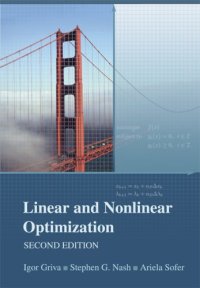
Ebook: Linear and Nonlinear Optimization
- Genre: Mathematics // Optimization. Operations Research
- Year: 2008
- Publisher: Society for Industrial Mathematics
- Edition: 2
- Language: English
- pdf
Part I of Linear and Nonlinear Optimization, Second Edition provides fundamentals that can be taught in whole or in part at the beginning of a course on either topic and then referred to as needed. Part II on linear programming and Part III on unconstrained optimization can be used together or separately, and Part IV on nonlinear optimization can be taught without having studied the material in Part II. In the preface the authors suggest course outlines that can be adjusted to the requirements of a particular course on both linear and nonlinear optimization, or to separate courses on these topics. Three appendices provide information on linear algebra, other fundamentals, and software packages for optimization problems. A supplemental website offers auxiliary data sets that are necessary for some of the exercises.
Audience: This book is primarily intended for use in linear and nonlinear optimization courses for advanced undergraduate and graduate students. It is also appropriate as a tutorial for researchers and practitioners who need to understand the modern algorithms of linear and nonlinear optimization to apply them to problems in science and engineering.
Contents: Preface; Part I: Basics; Chapter 1: Optimization Models; Chapter 2: Fundamentals of Optimization; Chapter 3: Representation of Linear Constraints; Part II: Linear Programming; Chapter 4: Geometry of Linear Programming; Chapter 5: The Simplex Method; Chapter 6: Duality and Sensitivity; Chapter 7: Enhancements of the Simplex Method; Chapter 8: Network Problems; Chapter 9: Computational Complexity of Linear Programming; Chapter 10: Interior-Point Methods of Linear Programming; Part III: Unconstrained Optimization; Chapter 11: Basics of Unconstrained Optimization; Chapter 12: Methods for Unconstrained Optimization; Chapter 13: Low-Storage Methods for Unconstrained Problems; Part IV: Nonlinear Optimization; Chapter 14: Optimality Conditions for Constrained Problems; Chapter 15: Feasible-Point Methods; Chapter 16: Penalty and Barrier Methods; Part V: Appendices; Appendix A: Topics from Linear Algebra; Appendix B: Other Fundamentals; Appendix C: Software; Bibliography; Index